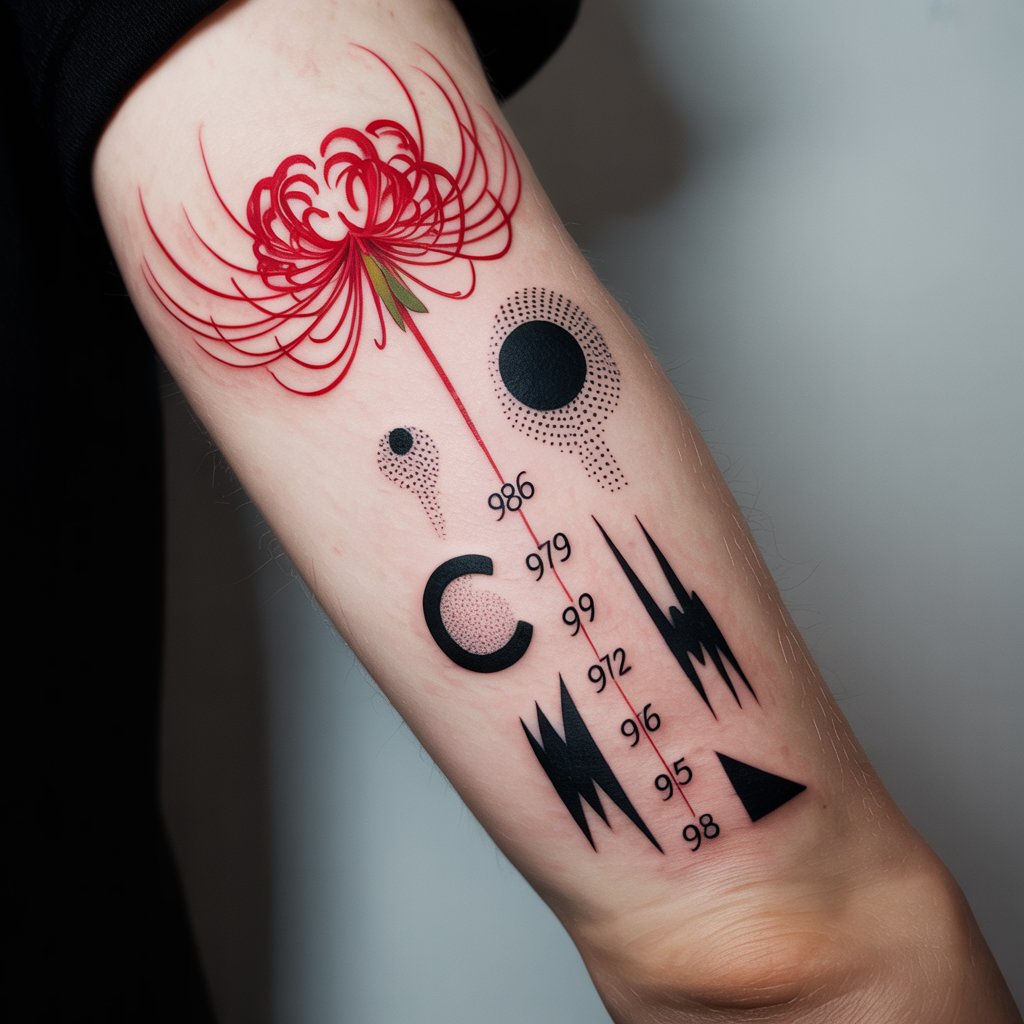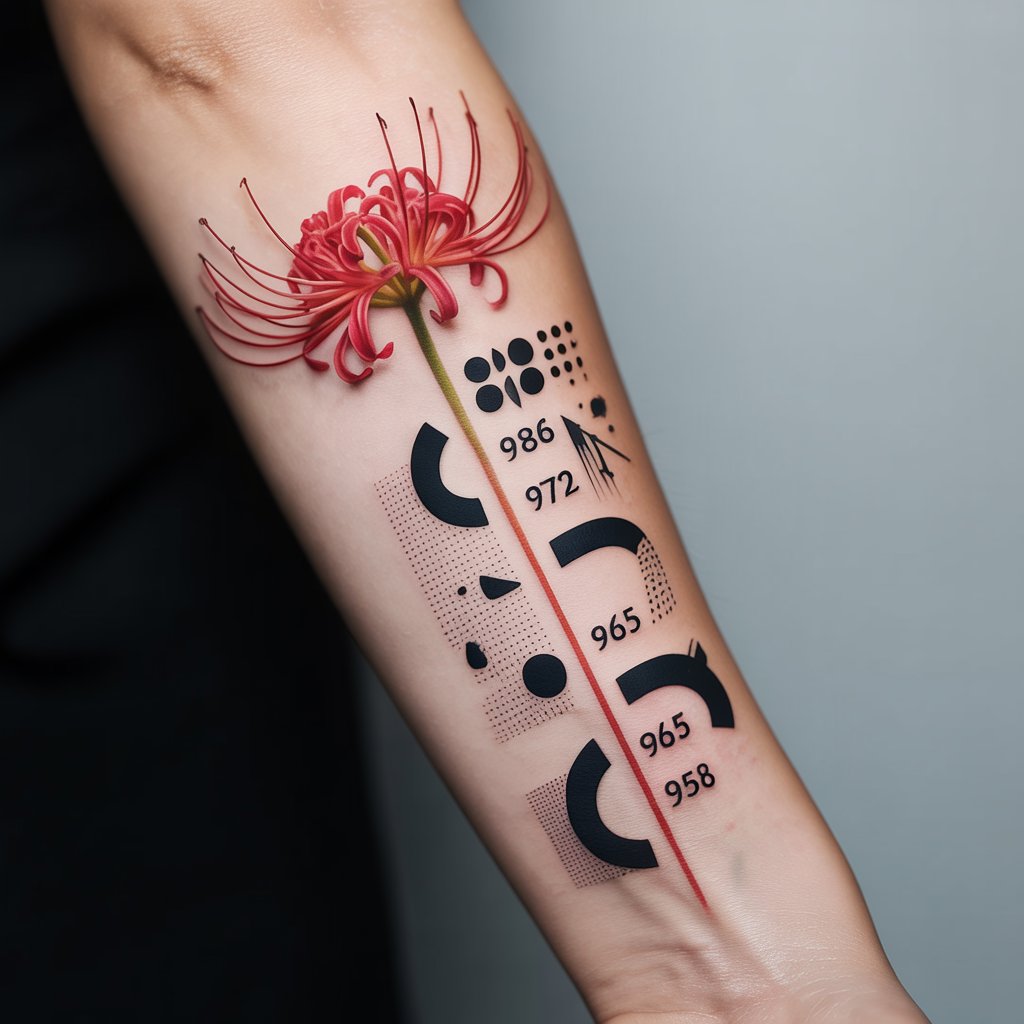In the ever-evolving world of tattoo artistry, a fascinating new trend has emerged at the intersection of realism, abstract graphic design, and botanical elements. These contemporary fusion tattoos combine seemingly disparate elements—vibrant natural imagery with geometric shapes, numbers, and abstract patterns—creating pieces that are both visually striking and deeply personal.
Breaking Traditional Boundaries
What makes these modern fusion tattoos particularly distinctive is their deliberate breaking of traditional tattoo conventions. Instead of adhering to a single style, artists are combining:
- Hyperrealistic botanical elements with vivid color work
- Abstract geometric patterns with dot work and fine lines
- Numerical sequences or data points with organic imagery
- Stark color contrasts (often red against black) for dramatic visual impact
The result is a visual language that speaks to our contemporary experience—a world where the natural and the technological, the organic and the constructed, increasingly coexist and intermingle.
The Symbolism of Juxtaposition
These tattoos often carry profound symbolic weight. The juxtaposition of elements tells a story:
- Natural elements (like the spider lily shown in vibrant red) often represent life, beauty, and the organic world
- Geometric patterns and numbers can symbolize order, human intervention, data, technology, or significant dates
- The contrast between them creates a narrative about the relationship between humanity and nature, or between emotion and logic
For many wearers, these designs express complex ideas about identity in the digital age—how we maintain our connection to the natural world while increasingly living in constructed, technological environments.
Technical Innovation
Creating these fusion pieces requires extraordinary technical skill and versatility. Artists must master:
- Color realism for botanical elements, requiring understanding of light, shadow, and color theory
- Precision linework for geometric elements and clean typographical components
- Composition balance to ensure coherence despite the contrast between elements
- Innovative use of negative space to create harmony between disparate elements
Many artists specializing in this style work digitally first, planning elaborate compositions before transferring them to skin, ensuring perfect placement and proportion.
The Spider Lily Design: A Case Study
The red spider lily (Lycoris radiata) tattoo combined with abstract geometric elements and numerical sequences exemplifies this fusion approach. In Japanese culture, the spider lily (higanbana) has complex symbolism—it’s associated with final goodbyes, death, and reincarnation, but also with reunion.
When paired with precise geometric patterns and numbers (potentially significant dates or coordinates), the flower’s organic flowing form creates a striking contrast. The vibrant red against black abstract elements achieves a visual tension that’s both beautiful and thought-provoking.

The Appeal of Personalization
What draws many to this style is the unprecedented potential for personalization. Each element can carry specific meaning:
- Numbers: Birth dates, coordinates of significant locations, or other meaningful sequences
- Geometric shapes: Personalized abstract representations of concepts or experiences
- Botanical elements: Chosen for their specific cultural symbolism or personal significance
This allows wearers to create deeply personal narratives that are simultaneously artistic and coded—legible to those who know the significance, but appearing simply as striking aesthetic choices to others.
Finding an Artist
Due to the technical complexity of these designs, finding the right artist is crucial:
- Look for portfolios demonstrating versatility across different styles
- Seek artists with experience in both realism and geometric work
- Consider artists with backgrounds in graphic design or digital art
- Expect longer consultations to develop these complex, personalized pieces
These tattoos typically require artists comfortable with both traditional tattooing techniques and digital design tools, as the planning stage is often as complex as the execution.
The Future of Fusion Designs
As tattoo artistry continues to evolve, we can expect to see even more innovative combinations of elements. The boundaries between traditional tattoo categories will likely continue to blur, with artists incorporating influences from digital art, data visualization, architecture, and other fields.
For those seeking body art that reflects the complexity of contemporary experience—the intersection of the technological and the natural, the personal and the universal—these fusion designs offer a compelling visual language that is simultaneously timeless and thoroughly modern.


